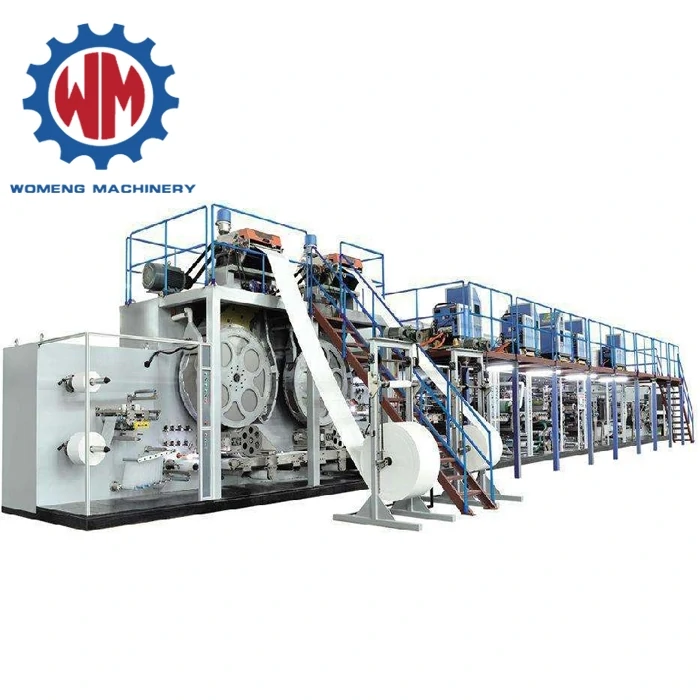Diaper machines incorporate several safety features to protect operators, prevent accidents, and ensure safe operation. These features include:
- Emergency Stop Buttons: Strategically placed emergency stop buttons allow immediate halting of the machine in case of emergencies or hazardous situations.
- Safety Guards and Enclosures: Machines are equipped with safety guards and enclosures to prevent operator contact with moving parts, hot surfaces, or other potentially dangerous areas of the equipment.
- Interlocking Systems: Interlocks ensure that certain machine functions can only operate when safety conditions are met. For instance, the machine may not start if safety guards are not properly closed or if doors are open.
- Safety Sensors and Alarms: Sensors detect abnormalities, excessive heat, or malfunctions, triggering alarms or automatically shutting down the machine to prevent accidents.
- Safety Signage and Instructions: Clear signage and instructions are displayed on the machine, providing guidelines for safe operation, emergency procedures, and hazard warnings.
- Training Programs: Operators undergo comprehensive training on machine operation, safety protocols, and emergency procedures to ensure they understand how to use the equipment safely.
- Overload Protection: Machines are equipped with overload protection mechanisms that prevent damage caused by excessive pressure, electrical overload, or mechanical stress.
- Automatic Shutdown Systems: In case of power fluctuations, circuit faults, or other critical issues, automatic shutdown systems activate to prevent unsafe operation and potential hazards.
- Fire Prevention and Suppression: Fire prevention measures such as fire-resistant materials, extinguishing systems, or fire alarms are incorporated to mitigate fire risks.
- Regular Maintenance and Inspections: Scheduled maintenance and routine inspections ensure that the equipment is in optimal condition, reducing the risk of malfunctions or accidents.
- Personal Protective Equipment (PPE): Operators are required to wear appropriate PPE, such as gloves, goggles, or safety shoes, diaper machine manufacturers to protect themselves while operating the machine.
By incorporating these safety features and protocols, diaper machines prioritize the well-being of operators, minimize the risk of accidents, and maintain a safe working environment in the manufacturing facility.
How is the diaper machine programmed to adapt to different sizes or variations in diaper designs?
Diaper machines are equipped with programming capabilities that allow for adaptation to different sizes or variations in diaper designs.
Here’s how they achieve this flexibility:
- Control Systems: These machines are controlled by sophisticated computerized systems that can be programmed to adjust various parameters such as length, width, shape, and placement of components.
- Adjustable Settings: Operators can input specific parameters into the machine’s control interface to modify settings for different diaper sizes or designs. These settings include dimensions, cutting patterns, adhesive application points, and layering configurations.
- Modular Design: Many diaper machines have a modular design, allowing for the addition or adjustment of modules or components to accommodate different sizes or configurations of diapers.
- Quick Changeover Features: Machines are equipped with quick changeover mechanisms that facilitate rapid adjustments between different diaper sizes or designs. This includes easily interchangeable tooling, cutting dies, or assembly components.
- Servo Control Systems: The use of servo motors provides precise control over various machine components, allowing for accurate adjustments in positioning, cutting, folding, and bonding of materials.
- Product Recipes or Profiles: These machines can store predefined settings or recipes for different diaper sizes or designs. Operators can select the appropriate profile, and the machine will automatically adjust its settings accordingly.
- Automatic Positioning and Alignment: Advanced machines utilize sensors and automated positioning systems that detect and align components based on predefined settings for each diaper size or design.
- Real-time Monitoring and Adjustments: Continuous monitoring of production parameters allows for real-time adjustments to ensure that each diaper meets the specified size and design requirements.
- Feedback Control Loops: Systems collect data during production and use feedback loops to make ongoing adjustments, optimizing the manufacturing process for different diaper variations.
By leveraging these programming and control capabilities, diaper machines can adapt seamlessly to produce various sizes, styles, and designs of diapers while maintaining precision, consistency, and efficiency in the manufacturing process.

Comments